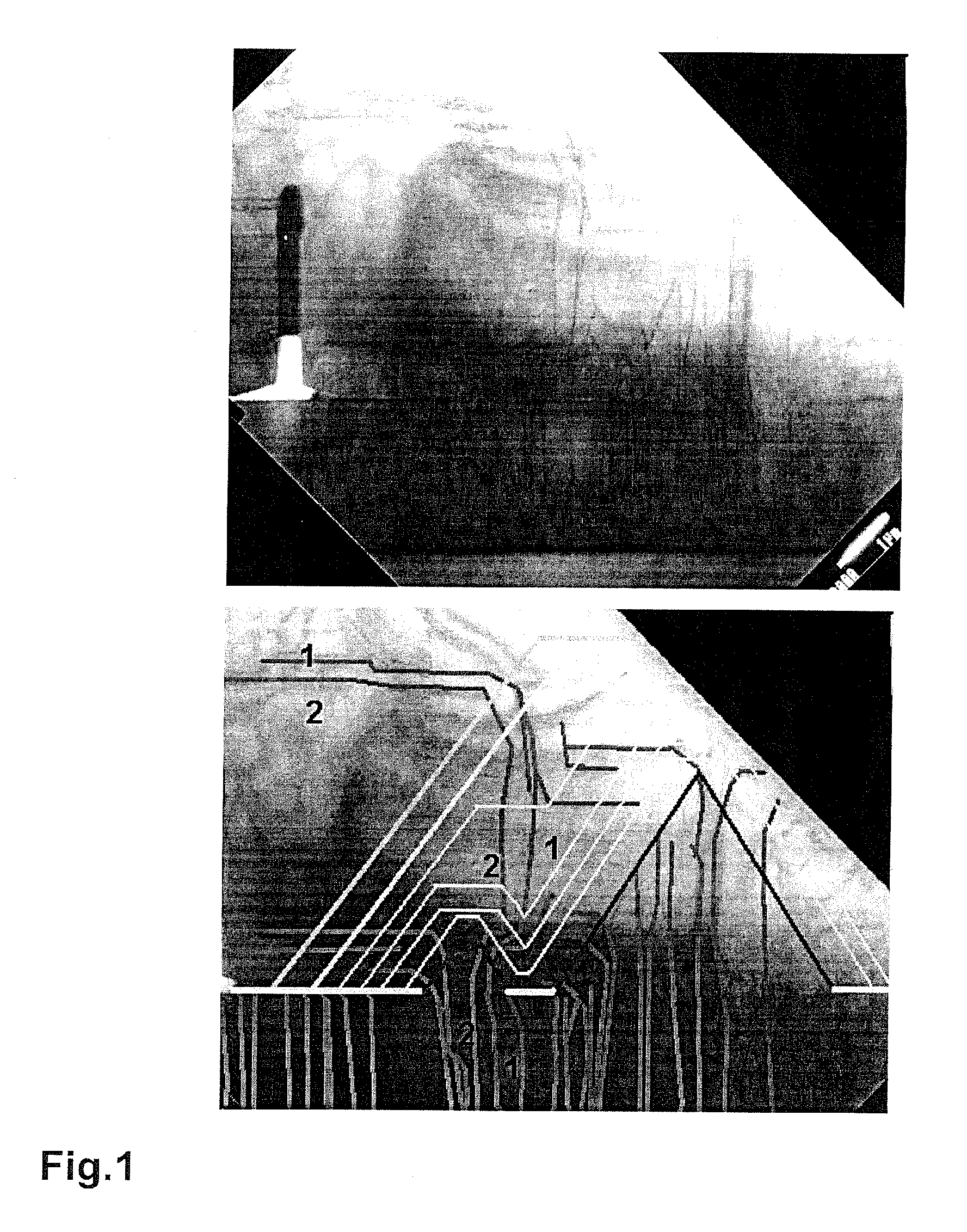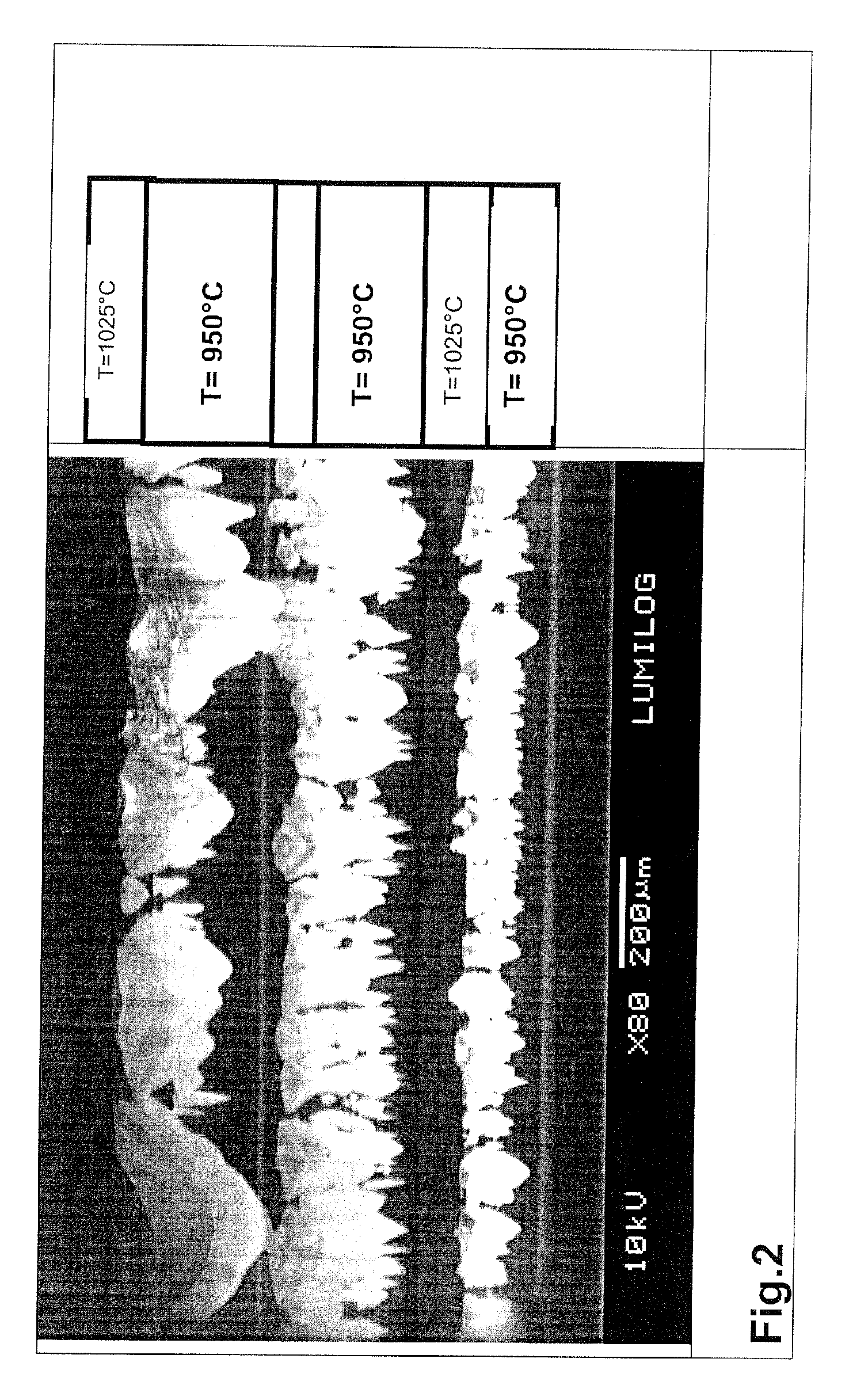Process for Growth of Low Dislocation Density Gan
a technology of dislocation density and growth process, which is applied in the direction of crystal growth process, polycrystalline material growth, chemically reactive gas growth process, etc., can solve the problems of low defect density, affecting the growth of low-defect density iii-n layers, and affecting the development of nitride materials, etc., to achieve the effect of low defect density
- Summary
- Abstract
- Description
- Claims
- Application Information
AI Technical Summary
Benefits of technology
Problems solved by technology
Method used
Image
Examples
example 1
Growth of GaN / Sapphire Template with ELO Quality by MOVPE
[0081]A (0001) sapphire substrate is used. A very thin film of silicon nitride is formed on the surface of the sapphire, the film being obtained by reaction between NH3 and silane SiH4 for a time short enough to limit the thickness of the film to that of about a few mono layers.
[0082]The gaseous vehicle is a mixture of nitrogen and hydrogen in equal proportions. The ammonia is introduced together with the silane, in a form diluted to 50 ppm in hydrogen. Under these conditions, the typical NH3 and SiH4 reaction time is of the order of 30 seconds. This reaction time could be increased up to 360 seconds. This creates either a continuous SiN layer (reaction time 60 seconds) or a discontinuous SiN layer with nanoholes of random size (deposition time 360 seconds)
[0083]The successive steps are monitored by laser reflectometry (LR). After the SiN layer coating, a continuous gallium nitride layer having a thickness of 20 to 30 nm is de...
example 2
Formation of a Free Standing GaN
[0085]Using the GaN / sapphire templates of example 1, the HVPE growth starts at about 950° C. In this low temperature step of growing a thick GaN layer by HVPE, the temperature is set at 930-950° C., the partial pressure of HCl, pHCl at 0.03, of NH3, pNH3 at 0.24, the carrier gas, H2, pH2 at 0.73 respectively. The growing pressure was 2.6 kPa.
[0086]After the low temperature step, formation of islands, growth temperature is set up to 1025° C., with the following values for the partial pressures of active and carrier gas:[0087]pHCl, 0.02[0088]PNH3, 0.31[0089]pH2, 0.67[0090]Working pressure: 2.6 kPa
[0091]In these growth conditions, the lateral growth rate is enhanced and the layer becomes flat. CL corresponding to this high temperature growth step appears as grey, because of the high quality of the GaN layer and the reduced incorporation of Oxygen.
[0092]The process is repeated several times until a thickness of 500 μm to 2 mm is obtained. CL examination o...
example 3
[0099]In this example, three alternate low-high growth temperature growth processes with different temperatures and durations are used. More specifically, it is shown that cross sectional optoelectronic properties of the HVPE layer are linked to the growth process.
[0100]The GaN / sapphire templates of example 1, is hereafter introduced in the growth chamber of the HVPE reactor.
[0101]The HVPE growth starts at about 930° C. In this low temperature step of growing a thick GaN layer by HVPE, the partial pressure of HCl, pHCl at 0.03, of NH3, pNH3 at 0.24, the carrier gas, H2, pH2 at 0.73 respectively. The growing pressure was 2.6 kPa. At this rather low temperature, GaN grows in the form of coherent island, randomly distributed with random size, thus involving a ULO process.
[0102]After the low temperature step, growth temperature is set up to 1015-1020° C., with the following values for the partial pressures of active and carrier gas:[0103]pHCl, 0.02[0104]PNH3, 0.31[0105]pH2, 0.67[0106]Wo...
PUM
 Login to View More
Login to View More Abstract
Description
Claims
Application Information
 Login to View More
Login to View More - R&D
- Intellectual Property
- Life Sciences
- Materials
- Tech Scout
- Unparalleled Data Quality
- Higher Quality Content
- 60% Fewer Hallucinations
Browse by: Latest US Patents, China's latest patents, Technical Efficacy Thesaurus, Application Domain, Technology Topic, Popular Technical Reports.
© 2025 PatSnap. All rights reserved.Legal|Privacy policy|Modern Slavery Act Transparency Statement|Sitemap|About US| Contact US: help@patsnap.com



